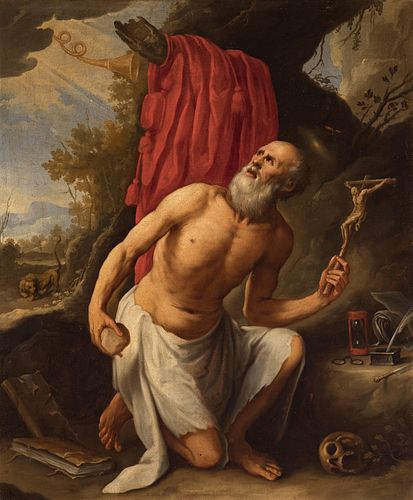Attributed to JOSÉ MORENO (Burgos, h. 1642-h. 1674). "St. Jerome penitent, Oil on canvas. Relined old.
Lot 54
About Seller
Setdart Auction House
Carrer Aragó 346
Barcelona
Spain
Setdart Subastas was born in 2004 and is currently the first online art auction in Spain with solidity, prestige and reliability guaranteed by our more than 60,000 users. Setdart has a young, dynamic and enterprising team ready to successfully manage the purchase and sale of art works through custom...Read more
Estimate:
EUR€7,000 - EUR€9,000
$7,526.88 - $9,677.42
Absentee vs Live bid
Two ways to bid:
- Leave a max absentee bid and the platform will bid on your behalf up to your maximum bid during the live auction.
- Bid live during the auction and your bids will be submitted real-time to the auctioneer.
Bid Increments
| Price | Bid Increment |
|---|---|
| EUR€0 | EUR€10 |
| EUR€200 | EUR€25 |
| EUR€500 | EUR€50 |
| EUR€1,000 | EUR€100 |
| EUR€3,000 | EUR€200 |
| EUR€5,000 | EUR€500 |
| EUR€10,000 | EUR€1,000 |
| EUR€20,000 | EUR€2,000 |
| EUR€50,000 | EUR€5,000 |
About Auction
By Setdart Auction House
Nov 3, 2021
Set Reminder
2021-11-03 08:00:00
2021-11-03 08:00:00
America/New_York
Bidsquare
Bidsquare : OLD MASTERS
https://www.bidsquare.com/auctions/setdart-auction-house/old-masters-7786
Setdart Auction House sofia@setdart.com
Setdart Auction House sofia@setdart.com
- Lot Description
Attributed to JOSÉ MORENO (Burgos, h. 1642-h. 1674). "St. Jerome penitent, Oil on canvas. Relined old. It has slight repainting and faults on the canvas. Measurements: 122 x 103 cm; 149 x 130 cm (frame). The representation of San Jerónimo, was one of the most recurrent themes during the reform. This is largely due to his work as a translator of the Bible, and precursor of the spread of the word of God. For this reason a very definite iconographic pattern was established with respect to the representation of the saint, this work being one of the best examples as it includes all the attributes that define the saint. An example of this is the skull, the lion, the stone he holds in his hand, the red mantle, the books, the trumpet, the feather and the hourglass that represents the passing of time. The scene stands out for the use of bright tonalities, both in the landscape and in the interior occupied by the saint, which provide a glorified vision of this traditional scene. One of the four great Doctors of the Latin Church, Saint Jerome was born near Aquileia (Italy) in the year 347. Baptized at the age of nineteen, between 375 and 378 he retired to the Syrian desert to lead an anchorite's life. He returned to Rome in 382 and became a collaborator of Pope Damasus. One of the most frequent representations of this saint is his penance in the desert. His attributes are the stone he uses to beat his chest and the skull on which he meditates. Also the cardinal's cape (or a red mantle), although he was never a cardinal, and the tamed lion. The latter comes from a story of the "Golden Legend", where it is narrated that one day, when he was explaining the Bible to the monks of his convent, he saw a lion coming with a limp. He removed the thorn from its paw, and from then on he kept it in his service, instructing it to look after his donkey while it grazed. Some merchants stole the donkey, and the lion recovered it, returning it to the saint without hurting the animal. There is little biographical information about José Moreno, to whom the Museo del Prado in his biography, attributes a Burgalese origin. However, other sources indicate that the painter, whose father was from Burgos, was born in Madrid. His relationship with painting is established through the deaths of his parents, who left as executors the painters Juan de Alfaro, Juan Montero de Rojas and Gregorio Fosman. In the biography of the Prado Museum, mention is made of the presence of José Moreno as a disciple of the workshop of Francisco Solís, located in Madrid. Palomino defines his painting highlighting the precise drawing, the clarity in the chosen tonalities and a great taste for decoration, bringing him closer to painters of the Madrid Baroque school, such as Alonso Cano and Sebastián Herrera Barnuevo, or Juan Carreño de Miranda. Palomino wrote in his book that the production of José Moreno was not very extensive, and that most of his works belonged to private collections. However, several works by the artist are preserved in collections accessible to the public, such as the Visitation, which is in the Prado Museum, The Flight into Egypt, of which there are several copies, and St. Francis and St. John the Baptist, which belong to the collection of the Provincial Museum of Fine Arts of Zaragoza.
- Shipping Info
-
In-house shipping available. Please inquire at admin@setdart.com.
-
- Buyer's Premium



 EUR
EUR CAD
CAD AUD
AUD GBP
GBP MXN
MXN HKD
HKD CNY
CNY MYR
MYR SEK
SEK SGD
SGD CHF
CHF THB
THB

















